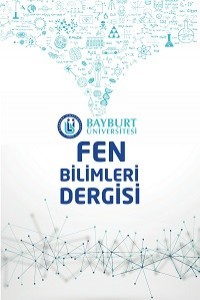Kurkuminin SARS-CoV-2 Üzerindeki Antiviral Etkileri Üzerine Moleküler Kenetlenme Analizi
COVID-19, Kurkumin, Antienflamatuvar, Konformasyon analizi, Moleküler Kenetlenme
Molecular Docking Analysis on the Antiviral Effects of Curcumin on SARS-CoV-2
COVID-19, Curcumin, Anti-inflammatory, Conformation analysis, Molecular Docking,
___
- [1] H. Gopinath and K. Karthikeyan, “Turmeric: A condiment, cosmetic and cure,” Indian Journal of Dermatology, Venereology and Leprology, vol. 84, no. 1, pp. 16, 2018.
- [2] S. Hewlings and D. Kalman, “Curcumin: A Review of Its’ Effects on Human Health,” Foods, vol. 6, no. 10, pp. 92, 2017.
- [3] J. Tabeshpour, M. Hashemzaei, and A. Sahebkar, “The regulatory role of curcumin on platelet functions,” Journal of Cellular Biochemistry, vol. 119, no. 11, pp. 8713–8722, 2018.
- [4] A. Ali and A. C. Banerjea, “Curcumin inhibits HIV-1 by promoting Tat protein degradation,” Scientific Reports, vol. 6, no. 1, 2016.
- [5] N. Zhang, H. Li, J. Jia, and M. He, “Anti-inflammatory effect of curcumin on mast cell-mediated allergic responses in ovalbumin-induced allergic rhinitis mouse,” Cellular Immunology, vol. 298, no. 1–2, pp. 88– 95, 2015.
- [6] M. S. Karimian, M. Pirro, M. Majeed, and A. Sahebkar, “Curcumin as a natural regulator of monocyte chemoattractant protein-1,” Cytokine & Growth Factor Reviews, vol. 33, pp. 55–63, 2017.
- [7] F. Zahedipour et al., “Potential effects of curcumin in the treatment of COVID ‐19 infection,” Phytotherapy Research, 2020.
- [8] H. Noor, A. Ikram, T. Rathinavel, S. Kumarasamy, M. Nasir Iqbal, and Z. Bashir, “Immunomodulatory and anti-cytokine therapeutic potential of curcumin and its derivatives for treating COVID-19 – a computational modeling,” Journal of Biomolecular Structure and Dynamics, pp. 1–16, 2021.
- [9] R. Jäger, R. P. Lowery, A. V. Calvanese, J. M. Joy, M. Purpura, and J. M. Wilson, “Comparative absorptionof curcumin formulations,” Nutrition Journal, vol. 13, no. 1, 2014.
- [10] L. Sun et al., “Coronavirus Papain-like Proteases Negatively Regulate Antiviral Innate Immune Response through Disruption of STING-Mediated Signaling,” PLoS ONE, vol. 7, no. 2, pp. e30802, 2012.
- [11] J. W. Schoggins and C. M. Rice, “Interferon-stimulated genes and their antiviral effector functions,” Current Opinion in Virology, vol. 1, no. 6, pp. 519–525, 2011.
- [12] D. Ting et al., “Multisite Inhibitors for Enteric Coronavirus: Antiviral Cationic Carbon Dots Based on Curcumin,” ACS Applied Nano Materials, vol. 1, no. 10, pp. 5451–5459, 2018.
- [13] Y. Imai et al., “Identification of Oxidative Stress and Toll-like Receptor 4 Signaling as a Key Pathway of Acute Lung Injury,” Cell, vol. 133, no. 2, pp. 235–249, 2008.
- [14] S. Rong et al., “Curcumin prevents chronic alcohol-induced liver disease involving decreasing ROS generation and enhancing antioxidative capacity,” Phytomedicine, vol. 19, no. 6, pp. 545–550, 2012.
- [15] M. Head-Gordon and et al. et al., “Advances in Methods and Algorithms in a Modern Quantum Chemistry Program Package,” ChemInform, vol. 37, no. 39, 2006.
- [16] T. A. Halgren, “Merck molecular force field. III. Molecular geometries and vibrational frequencies for MMFF94,” Journal of Computational Chemistry, vol. 17, no. 5–6, pp. 553–586, 1996.
- [17] A. Jurcik et al., “CAVER Analyst 2.0: analysis and visualization of channels and tunnels in protein structures and molecular dynamics trajectories,” Bioinformatics, vol. 34, no. 20, pp. 3586–3588, 2018.
- [18] O. Trott and A. J. Olson, “AutoDock Vina: Improving the speed and accuracy of docking with a new scoring function, efficient optimization, and multithreading,” Journal of Computational Chemistry, vol. 31, no. 2, 2009.
- [19] B. Zhang, Y. Zhao, Z. Jin, X. Liu, H. Yang, and Z. Rao, “The crystal structure of COVID-19 main protease in apo form,” 2020.
- [20] V. Nath, A. Rohini, and V. Kumar, “Identification of Mpro inhibitors of SARS-CoV-2 using structure based computational drug repurposing,” Biocatalysis and Agricultural Biotechnology, vol. 37, pp. 102178, 2021.
- [21] A. C. Walls, Y.-J. Park, M. A. Tortorici, A. Wall, A. T. McGuire, and D. Veesler, “Structure, Function, and Antigenicity of the SARS-CoV-2 Spike Glycoprotein,” Cell, vol. 183, no. 6, pp. 1735, 2020.
- Yayın Aralığı: Yılda 2 Sayı
- Başlangıç: 2018
- Yayıncı: Bayburt Üniversitesi
Uzamsal Alanda Bir Kripto-Stegano Hibrit Uygulama
Yenilikçi Tasarım Bakış Açısıyla İnsansı Robot Kol Parçası Tasarımı
Safer ÇOKATAR, Muhammet Tarık YILDIRIM, Hüseyin Hakkı BULDUK, Oğuzhan Sefa GÜNER, Ersin TOPTAŞ
Yağmur ZENGİN, Murat IHLAMUR, Hümeyra BAŞARI
Kurkuminin SARS-CoV-2 Üzerindeki Antiviral Etkileri Üzerine Moleküler Kenetlenme Analizi
A. Demet DEMİRAG, Sefa ÇELİK, Ayşen ÖZEL, Sevim AKYÜZ
Mehmet TÜRKMENOĞLU, Bayram Ali MERT, Mesut ANIL
Polianilin Kaplı Prinç Kabuğunun Atrazin Giderimi Üzerine Etkinliği
Alüminyum Alaşımlarına Uygulanan Sıvı Metal Temizliği Kontrol Yöntemlerinin İncelenmesi
Mehmet TOKATLI, Emin USLU, Murat ÇOLAK, Çağlar YÜKSEL
Ağır Metal Ekstraksiyonu için Patlıcan Bazlı Biyosorbentler
Doğu RAMAZANOĞLU, Zaman Adnan MOHAMMED, Idrees KHALO, Khalid MAHER
Sonlu Elemanlar Analiz Yöntemi Kullanılarak Blower Çark Tasarımının İyileştirilmesi
